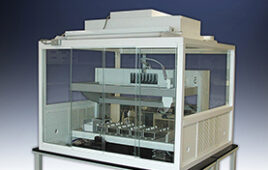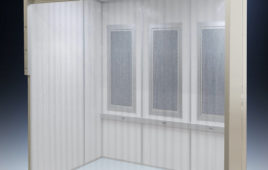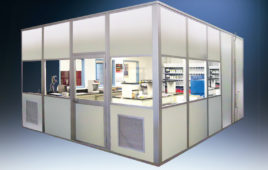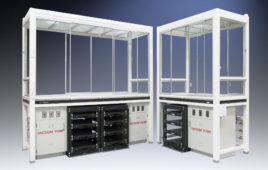“The world is a different place. The product and the business climate have changed,” claims Jan Wesley Refsdal, Director of Quality Assurance at Optiforms Inc., Temecula, Calif. Optiforms is a contract manufacturer of electroformed products and optical coatings. Contract manufacturers, frequently referred to as “job shops,” produce components for another firm; many manufacturers use contract manufacturers within their supply chain.
Continuing our series for Controlled Environments forecasting manufacturing by the year 2020, we talked with a number of experts involved with contract manufacturing to get their views on the potentials and challenges for contract manufacturing over the next few years.1-3
Growth
In a world requiring specialized skills and nimble response to changing requirements, contract manufacturing is likely to grow. “There is a great opportunity for small businesses,” asserts Refsdal. “Entrenched, behemoth companies can’t provide the same innovation or develop products as rapidly as can smaller, more agile suppliers.” Shawn Huber, Director of Operations at Medline Industries, a manufacturer and distributor of healthcare supplies headquartered in Mundelein, Ill., adds that “larger medical device manufacturers become dependent on contract manufacturing because of productivity constraints and because of the challenges of ramping up and down as demand and product lines change.”
“I don’t see a move to captive shops,” asserts Robert Dowell, President and CEO of Plasma Technology Inc. (PTI) of Torrance, Calif. and South Windsor, Conn., a provider of surface-engineered, coated components. “Boeing, PWA, GE, and other large OEM companies will do most of the R&D at their facilities. However, with the large amount of aircraft components requiring some kind of coating, these OEMs will count on their approved coating suppliers to support a majority of their new aircraft and engine requirements.” Refsdal adds that “larger companies will become the reliable integrator.”
“Since 2009, several coating suppliers have been purchased by large manufacturing companies,” notes Dowell, who predicts continued consolidation in the thermal spray industry over the next half dozen years. He expects PTI to continue to grow and expand while remaining independently owned.
Trends
Refsdal reflects, “In the late 1970s, the distribution of commercial to military was approximately 40/60. With the growth of air travel and tourism, contract manufacturing is predominantly in commercial aircraft, with the emphasis on fuel-efficient aircraft. We are spending more on high technology and less on massive defense systems.” Refsdal explains that Optiforms’ original business was making reflectors for analog projectors. “Today, we have hundreds of different applications, and the product mix constantly changes. Customer expectations have increased. The quality challenge is much greater with contract manufacturing. As contract manufacturers, we have to understand all of the business requirements; and we have to be aware of all of the resources.”
Dr. Satish Dixit, Director of Engineering/Research and Development at PTI, sees “tremendous growth in the military and non-military aerospace sectors, with demand increasing in India, China, and the sub-continents.” Dixit adds that “there will be a great demand in terms of surface engineering for products in medical instruments, high speed cars, and high speed rail systems.”
Jeff Yturbe, A&E Manager at Computrol Electronics Contract Manufacturing in Meridian, Idaho, sees a growing trend toward medical, military, and aerospace applications. Military applications continue to rely on RMA flux. Yturbe comments that “while RMA flux has cleaning challenges, it has been proven out by those military and aerospace customers, so they want to stick with it.”
Technology, innovation, and contamination
Dowell adds that while the emphasis will continue to be in aeronautics, other materials and additional markets including wind turbines are likely to grow. “We are working on new advanced developments in coating composites; this is definitely a growth area in the next five years.”
“You can’t dismiss technology changes in commercial aircraft,” adds Refsdal. “Previously, 80 percent would have been metallic. Now, roughly 50 percent of the content is carbon fiber.” Refsdal predicts the trend toward lightweight engineered materials such as carbon and ceramic fibers, as well as additive manufacturing, is likely to increase over the next five to six years. “This will enable production of more organic, highly engineered components that will ultimately cost less.” (Readers of Controlled Environments are probably aware that newer materials bring different challenges in terms of cleaning and materials compatibility issues and of the potential for contamination.)
Refsdal adds that the surface finishing industry is process-driven. “With electroform product, we are concerned with ion exchange and nanometer contamination. If it isn’t done right, the product is susceptible to environmental conditions.”
Customer interaction
Huber asserts that, instead of blindly following orders, a good contract manufacturer will question the customer. “Because requirements are constantly changing and are complex, the contract manufacturer may do what they think the customer needs, engaging in non value-added activities.”
R&D 100 AWARD ENTRIES NOW OPEN:
Establish your company as a technology leader! For more than 50 years, the R&D 100 Awards have showcased new products of technological significance. You can join this exclusive community! Learn more.
Huber adds that successful contract manufacturers will work to develop a symbiotic relationship with the customer. In these cases, the customer is more likely to stick with and continue to work with the contract manufacturer. “The concept of ‘no news is good news’ is not enough. Just because the customer is silent does not mean that all is well. It’s a matter of being proactive. Is the sales rep just ‘chauffeuring’ the contract? Is there negative chatter?”
Doug Sear, Facilities Manager at Optiforms, says that with multiple customers, “you have to know what customer you are building the part for. Each customer may have a different hot button.”
“In five years, contract manufacturers will have to become more entangled with the customer if they want to succeed,” concludes Huber. “A contract manufacturer could silently and without complaint struggle to fulfill requirements, only to find that the
customer has been investigating new contract manufacturers.”
Connie Conboy is Director, Strategy and Business Development at the Performance Review Institute in Warrendale, Pa. PRI administers process accreditation programs, including Nadcap (a global cooperative supplier accreditation program for aerospace engineering, defense, and related industries) and MedAccred (new industry managed medical device accreditation program for critical process suppliers). Conboy notes that contract manufacturers within the medical device supply chain are becoming more sophisticated. “They are beginning to work as partners with OEMs to provide rigorous oversight of their critical process supply chains. In the next five years, this will become a standard approach that contract manufacturers will use to provide product to customers. Contract manufacturers along with OEMs look at critical processes to determine how they can continue to improve final product quality and most importantly patient safety.” Conboy adds that “when we get major OEMs and contract manufacturers together in a room to clearly communicate critical process requirements and provide supply chain oversight, that collaboration becomes really important.”
References
1. Kanegsberg, B. and E. Kanegsberg, “20/20 Vision on Outsourcing,” Controlled Environments, October 2013.
2. Kanegsberg, B. and E. Kanegsberg, “2020 Pharma,” Controlled Environments, March 2014.
3. Kanegsberg, B. and E. Kanegsberg, “2020 Vision: Green, Safe, Sustainable,” Controlled Environments, Part 1: October 2014; Part 2: November/December 2014.
Barbara Kanegsberg and Ed Kanegsberg (the Cleaning Lady and the Rocket Scientist) are experienced consultants and educators in critical and precision cleaning, surface preparation, and contamination control. Their diverse projects include medical device manufacturing, microelectronics, optics, and aerospace. They can be reached at [email protected].
This article appeared in the January/February 2016 issue of Controlled Environments.




